9.1 Introduction
Fukushima Prefecture has 6820 ha of orchards in 2016 and it is one of the top fruit producing areas in Japan (National Statistics Center 2016). When looking at each kind of fruit, the area of the land under cultivation with peaches is the second largest in Japan (1810 ha), and this means that the prefecture is one of the major producers of fruit in Japan even after the Fukushima Daiichi nuclear accident. With regards to changes to the retail price of fruit, Komatsu (2014) and the author’s previous study (Takata 2016), show that most fruits have returned to their pre-accident prices, yet the situation is not the same as before.
Six years after the accident, the concentration of 134Cs is thought to be in low in fruit because its half-life is about 2 years. On the other hand, 137Cs, whose half-life is longer than 134Cs can still be detected. However, previous studies found that radiocesium in fruit decreased more quickly than its actual half-life; for example, the concentration of 137Cs decreased by one third in the second year, and by another one third in the third year after the accident (Takata et al. 2014, 2016). These results correspond to what was found in several types of fruit after the Chernobyl nuclear power plant accident (Antonopoulos-Domis et al. 1990; Madoz-Escande et al. 2004). However, there are few reports which traced and investigated products in the same region to examine a long-term transition of the concentration of radiocesium in fruit trees, and the future transition is uncertain. To understand this point, it is necessary to investigate the concentration of radiocesium not only in fruit continuously but also in trees which are the source of Cs in fruit. The author’s previous study found that radiocesium in soil has almost no relationship with Cs in fruit in most cases. This is because (1) the radiocesium transfer factor (TF) ratio for fruit is lower than annual crops in Japan, (2) trees are no longer affected by fallout which fell directly on bark, and largely contributed to the concentration of radiocesium in the fruit (Takata et al. 2012b, 2013a), (3) since radiocesium in the trees remain in situ year after year, this has become a source of radiocesium in fruit (Takata et al. 2012d, 2013c), and (4) most kinds of fruit in Fukushima Prefecture (except a few kinds such as blueberries) do not form their rooting zones within 5 cm from surface horizon and thus they do not absorb radiocesium, which was distributed only on the surface horizon unevenly (Takata et al. 2013b). The fourth reason is also related to the fact that potassium fertilizer has no effect in most cases. Therefore, it is necessary to investigate trees continuously to understand the source of radiocesium in fruit.
In this chapter, new research findings, after the author’s previous two reports stated above, are reported. Especially, understanding the dynamics of radiocesium in fruit and redistribution of 137Cs in trees 6 years after the accident is the focus.
9.2 The Year-Over-Year Transition of Radiocesium in Fruit
After the nuclear power plant accident, one variety of peach “Akatsuki” was investigated continuously regarding the concentration of radiocesium in the fruit in Shimo-oguni district, Ryozen-machi, Date City from harvest in 2001 to 2016. In 2011, the concentration of radiocesium in the harvested fruit was measured. From 2012 to 2016, the concentration of radiocesium and 40K was measured throughout fruit development: from Day 15 after the full bloom to harvest (approximately Day 103).
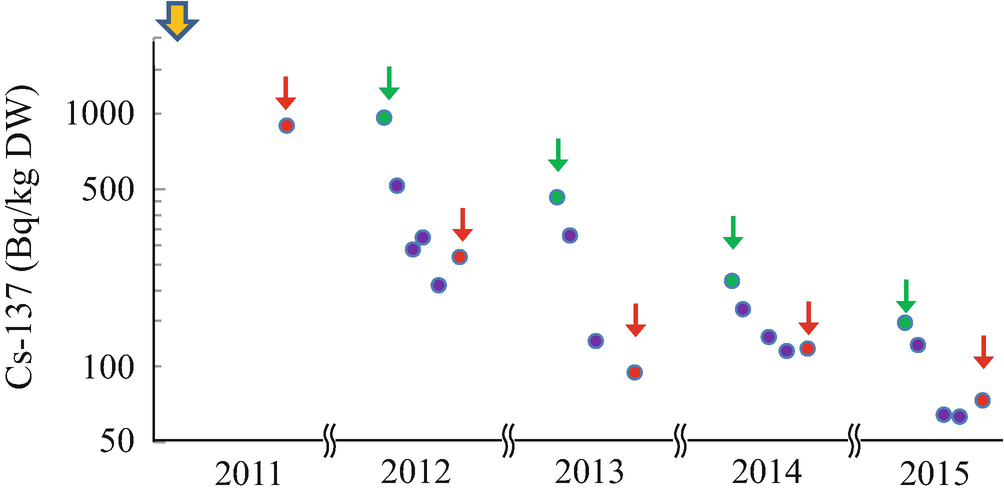
Seasonal change of 137Cs concentration in peach fruit from 2011 to 2016. The pink bars indicate the period of peach fruit growth from full bloom to harvest. The yellow arrow indicates the time of the accident (i.e., March 2011). The green dots indicate the young peach fruits 15 days after full bloom. The red dots indicate the peach fruits at harvest time. The purple dots are the peach fruits between youngest fruits and harvested fruits
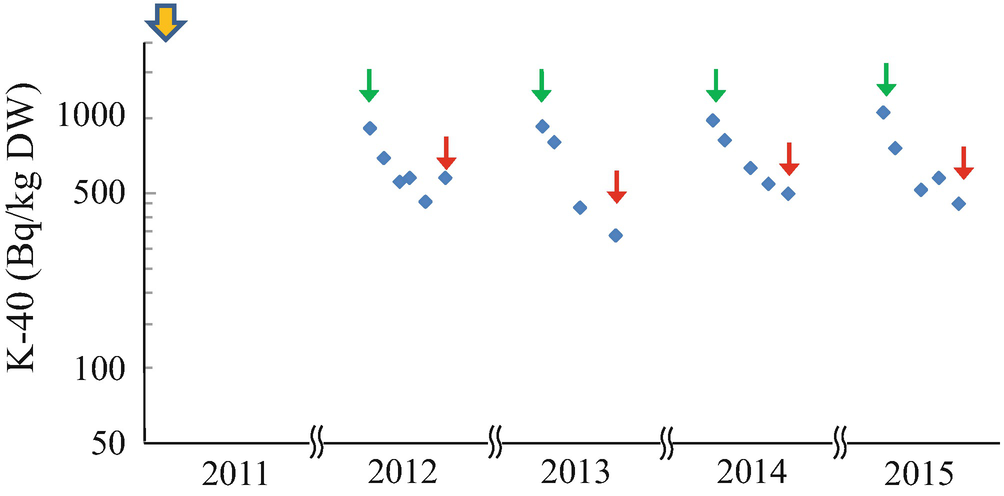
Seasonal change of 40K concentration in peach fruit from 2011 to 2016. The pink bar indicates the period of peach fruit growth from full bloom to harvest. The yellow arrow indicates the time of accident (i.e., March 2011. The green arrows indicate the young peach fruits 15 days after full bloom. The red arrows indicate the peach fruits at harvest time. The blue dots indicate the peach fruits between the youngest fruits and harvested fruits
9.3 The Year-Over-Year Transition of Radiocesium in Trees
Radiocesium was detected mainly in organs exposed to the atmosphere such as bark, because fruits trees are perennial plants and grew in the fields even at the time of the accident (in winter) (Takata et al. 2012a, d). Of course, fruit also absorb radiocesium from the soil through their roots, but it has already been confirmed that when considering the source of Cs in fruit, the ratio of radiocesium due to the fallout that adhered to the bark and was transferred to fruits is much higher than absorption through the roots. Therefore, it is important to grasp the transition of the concentration of radiocesium not only in the soil but also in the trees to understand the concentration in fruits. As stated in an earlier section, the concentration of radiocesium in peach fruit decreased as they matured and decreased over 3 years after the accident. It is important to understand the amount of radiocesium in trees to consider the cause of rapid decrease of the concentration over the 3 years after the accident; there is no report which investigated the amount of radiocesium in trees year-over-year. We introduce a study (Takata et al. 2016) which dug up trees after leaf fall to investigate the distribution of 137Cs and compare the dynamic of 137Cs in trees with that of 40K.
We used another variety of peach “Yuzora” planted in the fruit research center of Fukushima Agricultural Technology Center. The individual parts of peach trees of a similar age and planted in the same year were separated for the investigation from 2012 to 2014. Stems and branches were collected, and the branches were sorted according to their age. The roots were collected and sorted according to their thickness. The concentration of 137Cs and 40K in each part were measured and calculated using the dry mass of each part to convert the measured values into the quantities (expressed by Bq) of each organ.
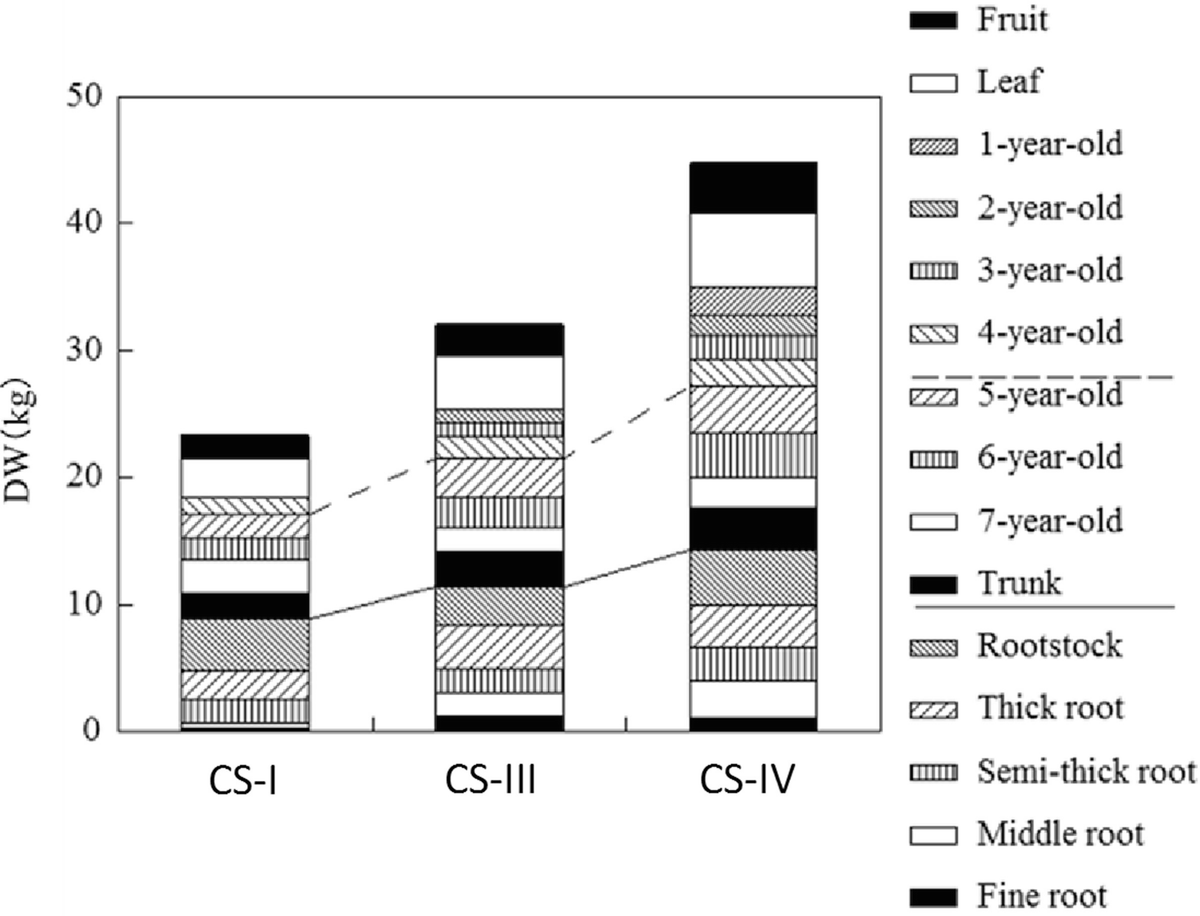
Annual changes in dry-weight of peach trees after the Fukushima Daiichi Nuclear Power Plant Accident (Takata 2016. CS: Cropping season after FDNPP accident, CS-I: 2011 summer, CS-III: 2013 summer, CS-IV: 2014 summer. Category of roots was divided by their thickness. Thick root: 10–20 mm in diameter, Semi-thick root: 5–10 mm, middle root: 2–5 mm, fine root: <2 mm
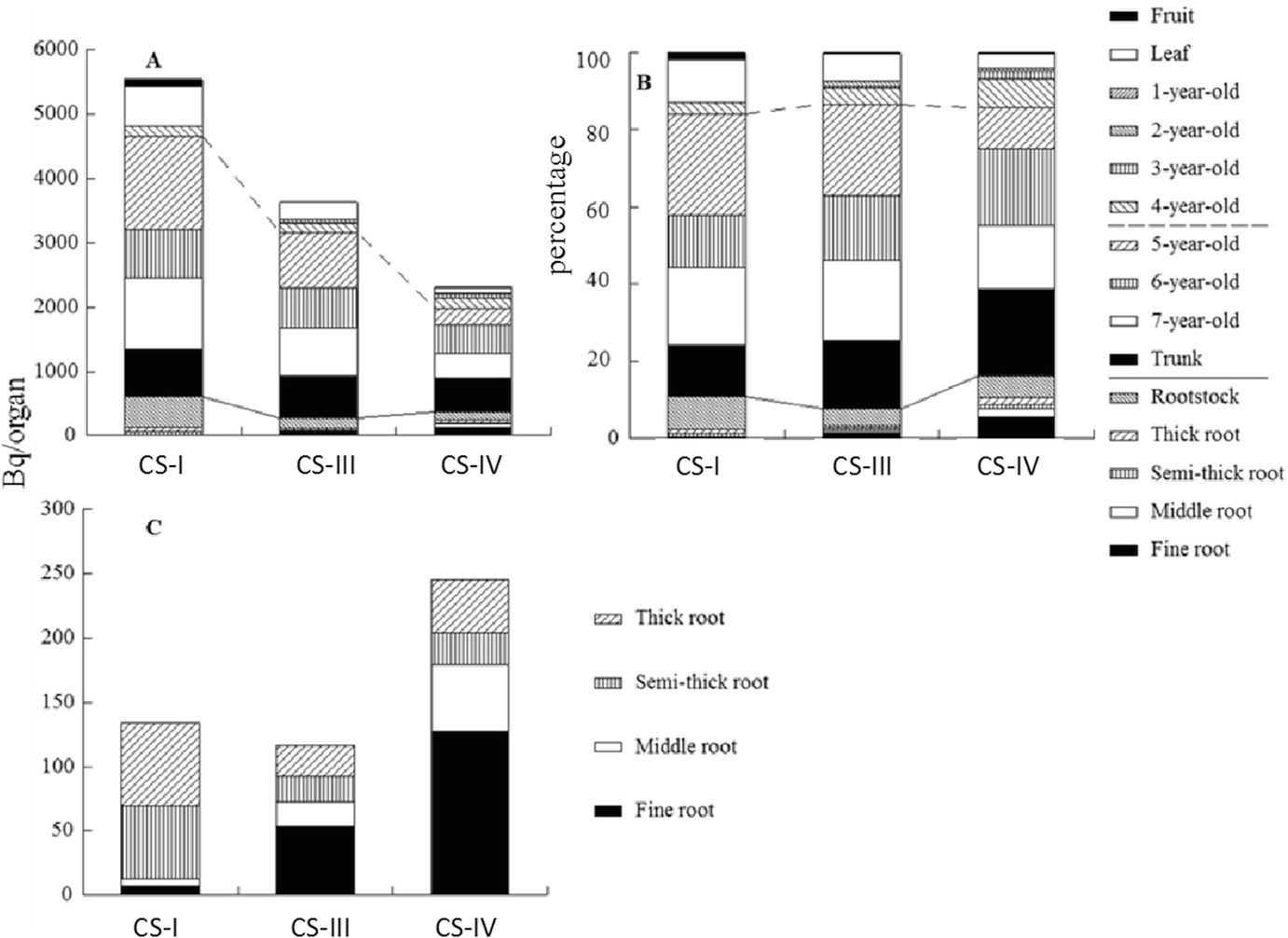
Annual changes in 137Cs content (A) and its distribution (percentage) (B) in peach trees after the Fukushima Daiichi Nuclear Power Plant Accident. Fig. 9.4C is an enlarged view of root 137Cs content (Takata 2016. Organs above the dashed line grew after the accident. Branch age conforms to cropping season 4 (2014). CS: Cropping season after FDNPP accident, CS-I: 2011 summer, CS-III: 2013 summer, CS-IV: 2014 summer. Category of roots was divided by their thickness. Thick root: 10–20 mm in diameter, Semi-thick root: 5–10 mm, middle root: 2–5 mm, fine root: <2 mm
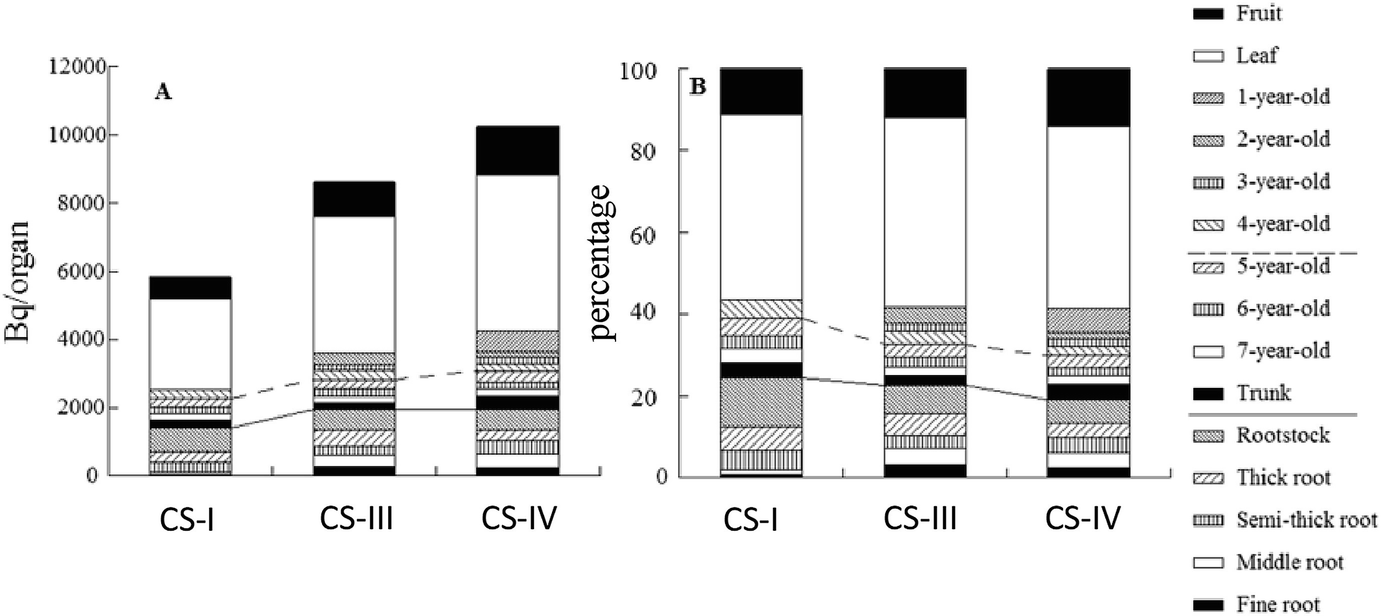
Annual changes in 40K content (A) and its distribution (percentage) (B) in peach trees after the Fukushima Daiichi Nuclear Power plant Accident (Takata 2016. Organs above the dashed line grew after the accident. Branch age conforms to cropping season 4 (2014). CS: Cropping season after FDNPP accident, CS-I: 2011 summer, CS-III: 2013 summer, CS-IV: 2014 summer. Category of roots was divided by their thickness. Thick root: 10–20 mm in diameter, Semi-thick root: 5–10 mm, middle root: 2–5 mm, fine root: <2 mm
Figure 9.4a shows that the total amount of 137Cs in trees was highest after 1 year and decreased in subsequent years. When looking at the year-over-year transition of each organ, 137Cs in five and seven-year-old branches and stems decreased. The five-year-old branches were the youngest branches which received fallout, and the seven-year-old branches were the main branches at the time of the accident. There was no year-over-year transition of the distribution of 137Cs in organs which did not receive the fallout: that includes branches younger than 4 years old, fruit and leaves (Fig. 9.4b), though the percentage of 137Cs which was transferred to fruit and leaves was 13.1% in the first year and decreased to 7.5% and 3.9% over the subsequent years. On the other hand, the distribution of 137Cs increased year-over-year in the four-year-old branches, which developed in the year of the accident. This could be because branches accumulated radiocesium as they grew, while new leaves and fruits were produced every year. Also, it is considered that the source of Cs in new-grown organs were the stems, five-year-old and seven-year-old branches which decreased the amount of 137Cs in them. However, five-year-old branches were pruned during winter and the cause of the decrease could be either the pruning or redistribution. Therefore, it is estimated that the source of 137Cs in new-grown organs were the stems and seven-year-old branches, which were not pruned.
Although there was no general tendency in the transition of the amount of 137Cs in the roots; the roots thinner than 5 mm and rootlets had higher amounts of 137Cs year- over-year (Fig. 9.4c). Two reasons can be considered to explain this phenomenon: (1) the absorption from the soil and (2) translocation from thick roots and terrestrial organs. However, as explained in an earlier section, radiocesium existed mainly in the surface horizon, especially to a depth of 5 cm rather than the lower horizons. Because the main root area of peach trees is deeper than the horizon, it is unrealistic that 137Cs can be absorbed by the roots. Therefore, it is considered that translocation from thicker roots contributes to the increase in the amount of 137Cs in medium and fine roots. The amount of 137Cs in the trees decreased more than the estimated quantity removed by fruit, leaves and pruned branches (Fig. 9.3a). It is necessary to consider other possibilities to explain this result such as 137Cs exudation from the surface of branches or roots and decay of rootlets. As mentioned earlier, a proportion of 137Cs is translocated to newly grown fine roots, and these new roots often decay in a single season. Therefore, 137Cs transferred to the soil by falling out or decay is not possibly negligible.
On the other hand, the total 40K in trees was smallest in the first year and increased with years; the increase in the fruit and leaves were considerable (Fig. 9.5). This result is closely related to the increase of weight of the trees (Fig. 9.3), and completely opposite to the year-over-year transition of 137Cs which was mentioned earlier.
During the 4 years of the investigation after the accident, it was found that the absorption of radiocesium from soil was much smaller than derived from the tree. The source of 137Cs in the fruits could be the stems and main branches, and the results show that 137Cs transferred from the stems or branches to fruits was not supplemented by the soil. On the other hand, 40K is transported from the soil through the stems and main branches. It suggests that the dynamics of Cs and K in fruits trees is different.
9.4 The Current Investigation
It is important to investigate the movement of 137Cs in trees, but its concentration will become too low to investigate like 134Cs when it reaches its half-life in the future. The dynamics of Cs need to be clarified in case a similar nuclear accident was to occur elsewhere in the world in the future. Although the dynamics of K, which is in the same group as Cs, is sometimes compared to understand the dynamic of Cs, it has been found that those dynamics are partially different in fruit trees. Therefore, the difference in the distribution of Cs and K in soil, absorption through roots, the transition from roots to terrestrial parts, and the transition rate from old to new organs can be obstacles to understanding the dynamics of Cs. Though comparing stable isotope 133Cs is another method, there are several problems to its use as an alternative to 137Cs. The analysis using high precision equipment is necessary to measure 133Cs in the natural environment though it is more abundant than 137Cs. Even if 133Cs is added to the environment to make the measurement easier, its dynamics and concentration may be different than 137Cs. Also, even if 133Cs was not added, the natural 133Cs may show a different dynamic from 137Cs because the natural 133Cs concentration is much higher than 137Cs. A simultaneous measurement of 133Cs and 137Cs is essential to solve these problems and it should be performed before the concentration of 137Cs becomes too low to measure. Now we found several results on the similarity and difference of dynamics and abundance between 133Cs and 137Cs. For example, the transfer factor ratio of 133Cs and 137Cs to fruit is likely to be similar when they are applied at the same time to blueberries. Other experiments such as spraying with 133Cs have been performed together with investigations using 137Cs. Also, the difference of dynamics of Cs which stored in terrestrial and subterranean tree parts has been analyzed.
Acknowledgments
This article is based on the collaborative research with Dr. Eriko Yasunaga, Dr. Haruto Sasaki, Dr. Keitaro Tanoi, Dr. Natsuko I. Kobayashi, Dr. Seiichi Oshita (the University of Tokyo) and Mamoru Sato, Kazuhiro Abe (Fukushima Prefecture Agricultural Technology Centre), with the assistance of Mr. Kengo Izumi, Mr. Kenichiro Ichikawa (the University of Tokyo). This study was partly supported by of Ministry of agriculture, forestry and fisheries (MAFF, Japan).

Open Access This chapter is licensed under the terms of the Creative Commons Attribution 4.0 International License (http://creativecommons.org/licenses/by/4.0/), which permits use, sharing, adaptation, distribution and reproduction in any medium or format, as long as you give appropriate credit to the original author(s) and the source, provide a link to the Creative Commons license and indicate if changes were made.
The images or other third party material in this chapter are included in the chapter's Creative Commons license, unless indicated otherwise in a credit line to the material. If material is not included in the chapter's Creative Commons license and your intended use is not permitted by statutory regulation or exceeds the permitted use, you will need to obtain permission directly from the copyright holder.